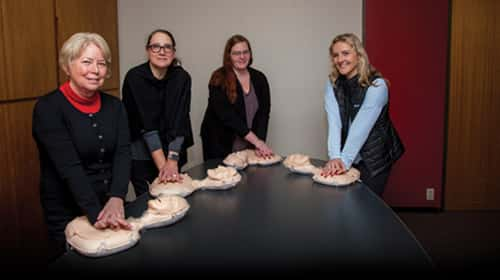Imagine this: You’re in your office working at your desk and a coworker approaches in distress, collapsing in front of you. What would you do? Your mind would probably race: Is this a heart attack? Does anyone know CPR? Isn’t there a defibrillator somewhere? Where is it? Does it still work? Does anybody know how to use it? By now you’re shouting, “Call 9-1-1!”
Every 27 seconds someone, somewhere in the U.S., is suffering a heart attack or a sudden cardiac arrest, according to the American Heart Association (AHA). Every year, 10,000 instances of sudden cardiac arrest will occur in the workplace. Those who receive immediate cardiopulmonary resuscitation (CPR)—within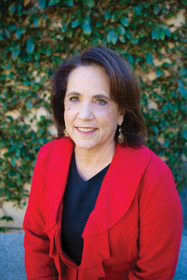 three to five minutes—before the EMTs arrive or before reaching the hospital, have double or triple chance of survival. Those for whom an automatic external defibrillator (AED) is also applied, see their chances of survival increase to 70 percent. This is not 100 percent, but is definitely a boost over CPR alone. However, according to an AHA survey, most workers questioned had not had access to CPR training; half could not locate an AED. For the coworker in front of you who’s suffering cardiac arrest, the story, without intervention, could be over in minutes.
three to five minutes—before the EMTs arrive or before reaching the hospital, have double or triple chance of survival. Those for whom an automatic external defibrillator (AED) is also applied, see their chances of survival increase to 70 percent. This is not 100 percent, but is definitely a boost over CPR alone. However, according to an AHA survey, most workers questioned had not had access to CPR training; half could not locate an AED. For the coworker in front of you who’s suffering cardiac arrest, the story, without intervention, could be over in minutes.
 three to five minutes—before the EMTs arrive or before reaching the hospital, have double or triple chance of survival. Those for whom an automatic external defibrillator (AED) is also applied, see their chances of survival increase to 70 percent. This is not 100 percent, but is definitely a boost over CPR alone. However, according to an AHA survey, most workers questioned had not had access to CPR training; half could not locate an AED. For the coworker in front of you who’s suffering cardiac arrest, the story, without intervention, could be over in minutes.
three to five minutes—before the EMTs arrive or before reaching the hospital, have double or triple chance of survival. Those for whom an automatic external defibrillator (AED) is also applied, see their chances of survival increase to 70 percent. This is not 100 percent, but is definitely a boost over CPR alone. However, according to an AHA survey, most workers questioned had not had access to CPR training; half could not locate an AED. For the coworker in front of you who’s suffering cardiac arrest, the story, without intervention, could be over in minutes. The American Heart Association is working closely with communities to correct this problem. “Only 46 percent of people who experience an out-of-hospital cardiac arrest get the immediate help they need before professional help arrives,” says Stacey Gibbons, executive director of the Western State Affiliate of the AHA in Santa Rosa. The AHA and local partner organizations are working to change this by making heart saving techniques, culture and tools available within the community. Businesses are important partners. “Businesses want to be a part of the solution since work is where many adults spend a significant amount of their time.”
The Petaluma Healthcare District (PHCD) works with the AHA by serving as a certified and authorized AHA, CPR and AED training center. “We follow the AHA/CPR/AED certification modules and they set the standards from which we train,” says Ramona Faith, Petaluma Healthcare District CEO. “We provide training on CPR and AED to the community and also to healthcare professionals.” While the two courses are similar, the one for healthcare professional certification is more extensive and meets the specific requirements for clinical health care providers.
PHCD has been offering Healthquest CPR certification classes for more than 35 years, and now manages the Petaluma HeartSafe Community Program, a nationwide program designed to create heart-saving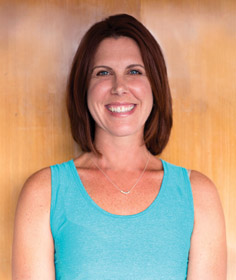 awareness and life-saving skills. PHCD is working together with the AHA and other local organizations and businesses to decrease the number of deaths and disabilities from a sudden cardiac arrest (SDA) outside the hospital through AED sales and AED/CPR/First Aid certification and training. “The goal,” says Faith, “is to save lives.”
awareness and life-saving skills. PHCD is working together with the AHA and other local organizations and businesses to decrease the number of deaths and disabilities from a sudden cardiac arrest (SDA) outside the hospital through AED sales and AED/CPR/First Aid certification and training. “The goal,” says Faith, “is to save lives.”
 awareness and life-saving skills. PHCD is working together with the AHA and other local organizations and businesses to decrease the number of deaths and disabilities from a sudden cardiac arrest (SDA) outside the hospital through AED sales and AED/CPR/First Aid certification and training. “The goal,” says Faith, “is to save lives.”
awareness and life-saving skills. PHCD is working together with the AHA and other local organizations and businesses to decrease the number of deaths and disabilities from a sudden cardiac arrest (SDA) outside the hospital through AED sales and AED/CPR/First Aid certification and training. “The goal,” says Faith, “is to save lives.” PHCD continues to find AEDs in the community that aren’t properly maintained and the AED owners don’t know how to use them. “We educate those who have AEDs about the importance of maintaining them and what the current legislation is on their roles and responsibilities are in owning an AED,” says Faith. Maintaining AEDs turns out to be surprisingly simple, but requires someone to pay attention on a regular basis. Batteries of AEDs need to be checked monthly, to make sure they are working. Also, the pads and supplies need to be replaced every couple of years. “It’s not difficult,” Faith says. “But if you don’t maintain them, you could find yourself with an AED that’s not functioning.” This simple maintenance routine could save a person’s life.
The current initiative that describes the importance of healthy life style changes and the availability of training in CPR/AED and First Aid in public places, is called HeartSafe. Schools are included in this initiative too, as no group is exempt from the possibility of sudden cardiac arrest. Young athletes have been known to suffer cardiac arrest on the field, and the benefits of having CPR/AED training, as of 2016, is recognized in every school in the Petaluma area as well as Shoreline Unified School District. There are now 31 HeartSafe Community Schools in the Petaluma area.
Businesses conduct an important outreach. “Arrow Benefits Group has partnered with the PHCD to encourage and support their clients in becoming a HeartSafe Business,” says Faith. Arrow has allocated $20,000 a year over the next five years to cover 50 percent of the AED purchase and HeartSafe Community (HSC) membership for their clients through the PHCD. The first business to take advantage of Arrow’s offer was Riverfront Fitness Studio, a small local gym in Petaluma.
Feeling safe at the gym
Pontius says they’ve been wanting an AED for a long time. They’re all CPR certified and have all learned the importance of having an AED. But as a small fitness studio, with only four staff members, the $1,800 to purchase the instrument was prohibitive. “The $1,800 AED is a huge chunk of money,” said Pontius. “Everyone I approached would say to me, ‘You can still save lives performing chest compression,’ which is true, but the AED is so much more of a sure thing when someone is suffering a cardiac arrest.”
She contacted the PHCD for advice. They informed her about the offer a partner business had put up to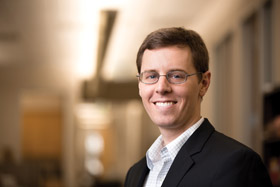 cover half the cost of the AED for anyone who wanted to become a HeartSafe business. They gave her the number for Andrew McNeil at Arrow Benefits Group in Petaluma.
cover half the cost of the AED for anyone who wanted to become a HeartSafe business. They gave her the number for Andrew McNeil at Arrow Benefits Group in Petaluma.
 cover half the cost of the AED for anyone who wanted to become a HeartSafe business. They gave her the number for Andrew McNeil at Arrow Benefits Group in Petaluma.
cover half the cost of the AED for anyone who wanted to become a HeartSafe business. They gave her the number for Andrew McNeil at Arrow Benefits Group in Petaluma.“Andrew was ready and willing to help in any way,” says Pontius, admitting she had been angling to get a total donation though he was only offering half. But his offer, as posted, was to pay half, so she took a deep breath and agreed to pay the $900. “Then he called back and said he’d spoken to his colleagues, and they agreed that because we were the very first to take him up on his offer, Arrow would donate the AED to us, which was really, generous,” she says, and we’re so thankful.” She says her gym’s AED is there purely for the use of their clients, should they ever need it, and that everyone who is CPR certified (all staff) is fully trained on the AED. As required for all personal trainers, she and her staff are re-certified on CPR and the AED every two years. Her gym doesn’t conduct trainings, but she does periodically rent out the studio space to Healthquest, an agency that does training in CPR and AED, and offers the training to the public, for a fee.
“The training walks you through the process of using the AED on a dummy,” says Pontius. Knowing that some people feel a little nervous about the AED, she says it’s really not scary at all, and also, if it doesn’t work, and you are giving the intervention on the scene and with good intentions, you’ll be protected by the Good Samaritan Law and will not be held liable should something go wrong. Pontius says she and her staff and her clients all feel safer knowing that they have an AED on the premises for their use, and that everyone who is trained on CPR is also trained on the AED.
Spreading the word
Andrew McNeil couldn’t be more pleased. “People like to learn how they can make an impact with others,” he says. “We started working with the PHCD to give CPR training to the employees of our clients. Then it quickly morphed into clients and community members,” he says. He partners with both the AHA and PHCD to further their HeartSafe initiatives. “We have trained dozens in CPR, AED, CPR/AED and First Aid.” They sponsor the class once a quarter, on a Saturday. “People commit six hours and spend all Saturday in our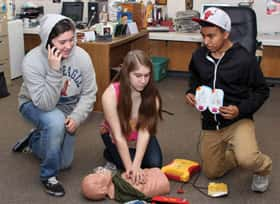 local hospital,” he says, explaining how that works.
local hospital,” he says, explaining how that works.
 local hospital,” he says, explaining how that works.
local hospital,” he says, explaining how that works. “You will have a dummy on the ground, a video and also a CPR instructor, who will walk you through how to do CPR, how many compressions vs. breaths,” he says. “So you’re going to get hands on experience with a fake person. You’re going to be doing everything you’d be doing in a real life situation. And couple that with the AED and you can then shock the dummy back to life.”
A lifesaving tool
The AED is the automated external defibrillator, which you may see at an airport, or in a public place, hanging on a wall, with a little picture of a heart on it. When someone has a cardiac arrest, you can do CPR, but the survival rate is only seven percent with CPR. When you use an AED, the electric pulse restarts the heart, improving the chances of survival to 70 percent. “It’s not foolproof, but it is a piece of the lifesaving process,” says McNeil.
The AED is not dangerous or complicated to use, the way it appears with the clappers on TV medical shows. “The AED machine has to detect a pulse, or lack of one, before it delivers a shock. So you can’t just hook it up to somebody and say, “Clear!” like they do on TV, and it delivers a shock. “If there’s a pulse, it does nothing,” he says. “If there is no pulse, it will deliver the right amount—automatically calibrated—of shock. “The computer in the unit does everything,” he says. “You place the pads on the person and turn it on, but once you turn it on, it searches for a pulse and if it says, ‘No pulse,’ you just push a button and away it goes.”
Supporting this initiative works with his business in several ways. First, they’re insurance brokers. Their mission is to keep their community healthy. Their volunteer work, like supporting the HeartSafe initiative is the extra that makes them special. “Anybody who knows insurance can consult on it,” he says. “What differentiates us from our competitors is really our dedication to our community.” His company has set aside $100,000 –$20,000 per year–over five years, to help those who want an AED machine for their businesses by paying for half the cost. Their offer reflects their recognition that the one workplace killer is cardiac arrest. They want to do what they can to defeat that. “I met a guy who had a cardiac arrest at the age of forty,” says McNeil. “He was pronounced legally dead—he now sells AED.” For McNeil, working with the AHA to help the community is part of the network of doing business, “I do a lot for the local branch, and they do a lot for me.”
Heart health as a mission
Kaiser Permanente is another strong support of the HeartSafe initiative and all efforts to promote heart health, from eating colorful veggies to hanging an AED on the wall and raising money to support the education effort. “About 10 years ago, we had raised close to $30,000 for the American Heart Association Heart Walk. Since then, our contribution had dwindled. I felt it would be great for one of the largest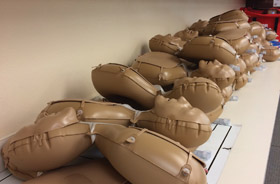 employers in Sonoma County, certainly in the healthcare arena, to have a good strong showing in the community supporting heart health, both financially as well as in participants.” says Kaiser Permanente Medical Office Group Controller, Troy Logan. Last year, as employees and physicians, they raised $38,970 in the Heart Walk, with over 250 participants. “From that perspective, we’re supporting the efforts in the community through the American Heart Association,” he says. He distributed AHA flyers to 35 participants of Leadership Santa Rosa, the fliers talk about heart healthy practices such as diet, eating colorful foods the importance of eating right, exercising, focusing on cardiovascular health and paying attention to cholesterol and staying active. He fully supports the HeartSafe initiative and the goal of getting AEDs in public places.
employers in Sonoma County, certainly in the healthcare arena, to have a good strong showing in the community supporting heart health, both financially as well as in participants.” says Kaiser Permanente Medical Office Group Controller, Troy Logan. Last year, as employees and physicians, they raised $38,970 in the Heart Walk, with over 250 participants. “From that perspective, we’re supporting the efforts in the community through the American Heart Association,” he says. He distributed AHA flyers to 35 participants of Leadership Santa Rosa, the fliers talk about heart healthy practices such as diet, eating colorful foods the importance of eating right, exercising, focusing on cardiovascular health and paying attention to cholesterol and staying active. He fully supports the HeartSafe initiative and the goal of getting AEDs in public places.
 employers in Sonoma County, certainly in the healthcare arena, to have a good strong showing in the community supporting heart health, both financially as well as in participants.” says Kaiser Permanente Medical Office Group Controller, Troy Logan. Last year, as employees and physicians, they raised $38,970 in the Heart Walk, with over 250 participants. “From that perspective, we’re supporting the efforts in the community through the American Heart Association,” he says. He distributed AHA flyers to 35 participants of Leadership Santa Rosa, the fliers talk about heart healthy practices such as diet, eating colorful foods the importance of eating right, exercising, focusing on cardiovascular health and paying attention to cholesterol and staying active. He fully supports the HeartSafe initiative and the goal of getting AEDs in public places.
employers in Sonoma County, certainly in the healthcare arena, to have a good strong showing in the community supporting heart health, both financially as well as in participants.” says Kaiser Permanente Medical Office Group Controller, Troy Logan. Last year, as employees and physicians, they raised $38,970 in the Heart Walk, with over 250 participants. “From that perspective, we’re supporting the efforts in the community through the American Heart Association,” he says. He distributed AHA flyers to 35 participants of Leadership Santa Rosa, the fliers talk about heart healthy practices such as diet, eating colorful foods the importance of eating right, exercising, focusing on cardiovascular health and paying attention to cholesterol and staying active. He fully supports the HeartSafe initiative and the goal of getting AEDs in public places. “I think it would be extremely helpful in our community to have these AEDs located in restaurants and gyms and other places where people gather,” he says. “In an emergency, you can pull it off the wall, take it to the person who you believe is having a heart attack, put the leads where the machine tells you, and it will tell you if the person needs or doesn’t need it. It walks you through the entire process and potentially can save a life. Having these in the right places, where people gather, would be of tremendous benefit to the community. I’d like to see more attention in the community for these to become even more low cost so organizations can acquire them.”
Saving lives
“You’ll never know when you’ll need to save a life,” says AHA Executive Director Stacey Gibbons. “Yet new AHA research shows that most U.S. employees aren’t prepared to handle health emergencies in the workplace because they lack training in CPR and First Aid.” She asks, “Are you one of the 50 percent who can locate an AED at work? With 10,000 cardiac arrests annually in the workplace, this small piece of information has the potential to save thousands of lives. Immediate CPR and use of an AED can double survival rates. Is your workforce prepared to respond?”
Cardiac Arrest and Heart Attack—what’s the difference?
Cardiac arrest: The word “arrest” means to stop. In a sudden event of a cardiac arrest, the heart stops, blood flow stops, breathing stops and consciousness is lost. Without intervention, the person will die within minutes.
The fault is an “electrical malfunction” in the heart that causes arrhythmia (irregular heartbeat). This can be caused by a heart attack.
Symptoms: Sudden collapse, lack of pulse, no breathing and loss of consciousness. Sometimes symptoms of a heart attack precede sudden cardiac arrest, but cardiac arrest can occur without warning.
What to do if you think someone is suffering cardiac arrest: Call 9-1-1 immediately and then begin CPR. Apply an AED as soon as possible.
Heart attack: This is a circulation problem and happens when blood flow to the heart is blocked and blood only reaches part of the heart. The part that isn’t reached and nourished will die.
Symptoms: Pain can be immediate and discomfort can go on for hours, or days. The longer the person goes without treatment, the greater the damage to the heart. Symptoms in women can be different than in men, and may include back or jaw pain.
Unlike the heart in sudden cardiac arrest, the heart “under attack” usually keeps beating, but the patient may experience discomfort in the chest or upper body, shortness of breath, cold sweats, nausea and vomiting. Cardiac arrest may follow.
What to do if you think someone is suffering a heart attack: Call 9-1-1, even if you’re not sure. Notify the EMS staff, so they can begin treatment as soon as they arrive.
96
Normal
0
false
false
false
EN-US
JA
X-NONE
Programs and Partnerships for Healthy Hearts
Roundtable: American Heart Association chief executive officers joins scientific and business expertise to find better ways to promote “evidence based” approaches to workplace health.
www.https://playbook.heart.org
Healthy For Good: This is a national four-step movement to inspire lifestyle changes by teaching that health is fun, natural and easy as “eat smart, add color, move more so you can be well.”
www.healthyforgood.heart.org
Go Red for Women: This is a national movement to end heart attack and stroke among women. Go Red For Women encourages awareness of the issue of women and heart disease, and also encourages action to save more lives.
www.goredforwomen.org
www.goredforwomen.org
AED, CPR and First Aid Implementation programs are all described on their web page:
www.cpr.heart.org/AHAECC/CPRAndECC/Programs/AEDImplementation/UCM_473198_AED-Implementation.jsp
www.cpr.heart.org/AHAECC/CPRAndECC/Programs/AEDImplementation/UCM_473198_AED-Implementation.jsp
AED Grants from AHA: Look here to find deals so that more people can make these life-saving tools and techniques available.
www.cpr-savers.com/AED-Grant-Programs_ep_51-1.html
www.cpr-savers.com/AED-Grant-Programs_ep_51-1.html
HeartSafe Communities: This is a program that helps communities prevent sudden cardiac arrest (SCA). www.heartsafe-community.org/


